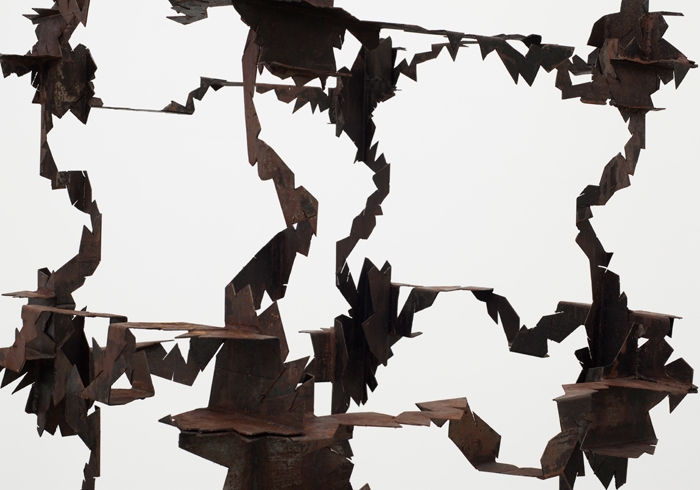Luciana Lamothe makes sculptures out of humble building materials such as plywood, iron piping and scaffolding clamps. Here she ditches the planks to make a set of nine works from only pipes and bolts, six of which are mounted on white blocks. Of the three others, Curtain (2017–18) hangs from the ceiling: more than 30 rusted iron pipes attached in a vertical arrangement by steel scaffolding clamps. It’s an iron curtain you can walk around and peer through, so perhaps more like a colossal set of Venetian blinds.
The work is a reminder that barriers, even if seemingly impenetrable, can be circumnavigated. Lamothe corrodes the ends of each pipe with acid; the inorganic material is transformed into biomorphic shapes. From a distance these degraded pieces of metal look in parts like rotting tree branches, in others like spent leaves about to fall. Get nearer and the shards look almost edible, like chocolate flakes. But closer still the impact is more gruesome – tiny bits of metal soldered to the scarred slivers that look like ants feeding on a decomposing windpipe.
Punctual (2017) is a three-metre-tall pillar that stretches from the floor to the ceiling to meet a Doric capital. Seen from afar this might resemble a model skyscraper – a stack, like the Barbican in London with its balconies, or more organically a spine, as with Santiago Calatrava’s Turning Torso in Malmö, with its spondylitic vertebrae. It is made solely from iron piping, cut so that curved triangular teeth protrude threateningly from the central column. The wallmounted work Untitled (2017) takes a single iron pipe that has been incised in a spiral, the cut resulting in another viciously sharp dentition. The single helix resembles a model of RNA or a banded snake stiff with rigor mortis.
A paradox arrives with Flancito (2018), a rectangular construction in which parts of the iron pipes are cut into jagged, lightning-bolt forms. These are as menacingly sharp as the protective devices atop property walls here in paranoid Buenos Aires. But these cutouts can also be imagined as an interconnected chain of dancing figures. And that title refers to something sweeter too – the crème caramel desserts the locals love and whose burnt surfaces are the colours of the degraded pipes. Two more untitled works from 2017 feature circular structures that complement one other, the first resembling a gigantic hair roller, and the other a Medusa’s head of writhing snakes.
Lamothe’s new works are significantly smaller than her previous architectural interventions but possess a similar aura of incipient danger. These unnerving constructions seem at odds with Argentina’s consumerist culture, the excesses of which can be found in properties guarded from the public by the heavy gates and wall spikes that these metal sculptures resemble.
Luciana Lamothe: Ensayos de abertura, Ruth Benzacar, Buenos Aires, 7 March – 21 April 2018
From the Summer 2018 issue of ArtReview
